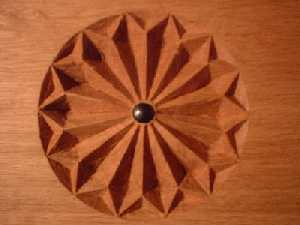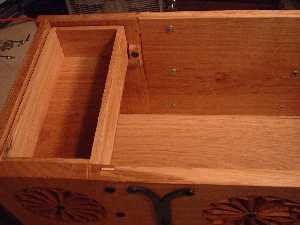|
Summary The chest was made for Baroness Lucia Bellini, based on the chest in Laneham Church, Nottinghamshire, England. It is constructed from European oak, and was carved by hand. It uses the same joinery as the original but has some custom modifications based on Lucia's preferences. I hand made the steel strapping (from straight mild steel), hand hammered the hinges, and blued the rivets. It was assembled by hand. The bottom floats slightly in a dado joint so it can expand and contract without affecting the other joinery. It is finished with lemon oil in accordance with Lucia's preference.
|
||
 |
 |
|
| A view of the front of the chest. (27kb) | The front and top of the chest, showing how the iron strapwork wraps all the way around. (22kb) | |
|
Design This chest is patterned after a 13th century chest that is in
Laneham Church, Nottinghamshire, England. The original chest is made of oak, and
is sitting in the back of the church holding Christmas ornaments. I originally
saw the chest in a black and white photo in Furniture, 700-1700, by Eric Mercer.
I then traveled to Laneham to view and take photos of the original chest. This
chest was made for Baroness Lucia Bellini, who is making my laurel scroll. She
had some particular preferences for the chest, so I have made some design and
construction changes from the original, in accordance with her wishes. The
design changes are: The remainder of the design is based upon the original. The sides are joined to the front and rear using dado joints as shown in figure 6. The front panels are joined using tongue and groove as in the original. The three panels are chip carved using the sunflower/palmette design of the original and the styles have the arcading of the original. The steel straps are shaped according to the original, with the "Y" pattern, and the hinges being incorporated into the straps in the similar manner as the original hinges. The movement of the hinge placement, made necessary by the entire top being the lid, made for some interesting design work to make the lid flip completely open. The hinge design is the same as those of the original chest.
|
||
 |
 |
|
| An oblique angle of the chest, showing the
strapwork on the ends of the box as well. (23kb)
|
A close up of the chip-carved roundel. (27kb) | |
 |
 |
|
| The interior of the chest showing the removeable tray. The tray in the original is not removeable. (24kb) | Another view of the interior, showing the
tray support brackets. (23kb)
|
|
|
Materials: I used European oak for the chest. Oak is (or at least was) one of the most common trees in England. It is a nice carving wood and exceptionally strong and durable. I used 20mm wide mild steel for the strapping. The original had large forged metal nails (1" diameter heads) used for the pinning the tongue and groove joints, and to attach the steel strapwork. The nails were either clinched over, or clipped off. In order to find something that approximated the head size, I chose to use carriage bolts, which could be blued and then peened over like rivets.
|
||
 |
 |
|
| Another shot of the front and top. | A slightly different shot of the interior. | |